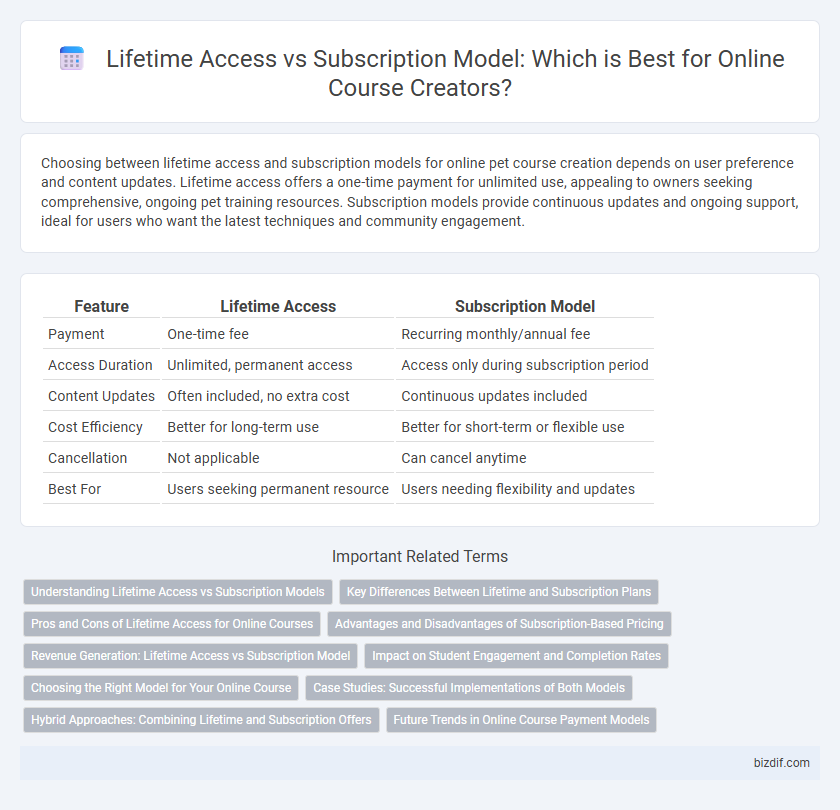Choosing between lifetime access and subscription models for online pet course creation depends on user preference and content updates. Lifetime access offers a one-time payment for unlimited use, appealing to owners seeking comprehensive, ongoing pet training resources. Subscription models provide continuous updates and ongoing support, ideal for users who want the latest techniques and community engagement.
Table of Comparison
| Feature | Lifetime Access | Subscription Model |
|---|---|---|
| Payment | One-time fee | Recurring monthly/annual fee |
| Access Duration | Unlimited, permanent access | Access only during subscription period |
| Content Updates | Often included, no extra cost | Continuous updates included |
| Cost Efficiency | Better for long-term use | Better for short-term or flexible use |
| Cancellation | Not applicable | Can cancel anytime |
| Best For | Users seeking permanent resource | Users needing flexibility and updates |
Understanding Lifetime Access vs Subscription Models
Lifetime access offers learners unlimited entry to course materials after a one-time payment, providing flexibility and long-term value. Subscription models require ongoing payments, granting continuous updates and access to a broader range of courses, which encourages consistent engagement. Choosing between lifetime access and subscriptions depends on learner preferences for ownership versus evolving content availability.
Key Differences Between Lifetime and Subscription Plans
Lifetime access grants students unlimited, one-time payment entry to course materials, promoting long-term value without recurring fees. Subscription models require ongoing payments, offering continuous updates and access to evolving content but may result in higher cumulative costs. Choosing between these plans depends on learner commitment, budget flexibility, and preference for content updates over time.
Pros and Cons of Lifetime Access for Online Courses
Lifetime access for online courses offers learners unlimited entry to course materials, promoting flexible study schedules and long-term skill retention. This model can enhance student satisfaction and perceived value but may limit recurring revenue for course creators compared to subscription-based models. However, lifetime access requires continuous content updates and technical support, potentially increasing maintenance costs for the provider.
Advantages and Disadvantages of Subscription-Based Pricing
Subscription-based pricing for online courses offers steady, predictable revenue streams and encourages continuous learner engagement through regular content updates. However, this model may cause potential revenue loss if users cancel subscriptions early and can create challenges in maintaining consistent course quality to justify ongoing payments. Balancing subscriber retention with content value is essential to optimizing profitability in the subscription model.
Revenue Generation: Lifetime Access vs Subscription Model
Lifetime access courses generate immediate, concentrated revenue from one-time payments, appealing to learners who prefer full ownership of content. Subscription models ensure steady, recurring income streams by charging periodic fees, fostering long-term customer engagement and higher lifetime value. Choosing between these models depends on business goals, with lifetime access maximizing upfront cash flow and subscriptions optimizing consistent revenue growth.
Impact on Student Engagement and Completion Rates
Lifetime access to online courses typically boosts student engagement and completion rates by allowing learners to progress at their own pace without time constraints. Subscription models may encourage continuous learning habits but risk lower completion rates if students unsubscribe prematurely. Data shows that flexible access correlates strongly with higher course completion and sustained skill retention.
Choosing the Right Model for Your Online Course
Choosing the right model for your online course depends on your target audience's preferences and long-term revenue goals. Lifetime access offers learners unlimited, one-time payment access, enhancing customer value and satisfaction. Subscription models generate consistent monthly income and encourage ongoing content updates, making them ideal for evolving or regularly updated courses.
Case Studies: Successful Implementations of Both Models
Case studies reveal that lifetime access models, as implemented by platforms like Udemy, foster strong user loyalty and higher upfront revenue through one-time payments, while subscription models like Coursera's generate steady, recurring income and encourage continuous engagement. Successful implementations show that lifetime access appeals to learners seeking long-term resource availability, whereas subscription models benefit users prioritizing varied and updated content. Data indicates a hybrid approach can maximize market reach by catering to diverse learner preferences and optimizing revenue streams.
Hybrid Approaches: Combining Lifetime and Subscription Offers
Hybrid approaches in online course creation blend lifetime access and subscription models, providing flexibility and catering to diverse learner preferences. Offering core content with lifetime access while frequently updating material through subscription tiers maximizes revenue and engagement. This combination enhances customer loyalty by delivering both immediate value and continuous learning opportunities.
Future Trends in Online Course Payment Models
The future of online course payment models is shifting toward hybrid options that combine lifetime access with subscription benefits, enhancing learner flexibility and value. Subscription models are evolving to include tiered access and curated content libraries, catering to varying user needs and promoting ongoing engagement. Data shows that personalized payment plans significantly increase course completion rates and learner satisfaction in the evolving digital education landscape.
Lifetime Access vs Subscription Model Infographic

 bizdif.com
bizdif.com